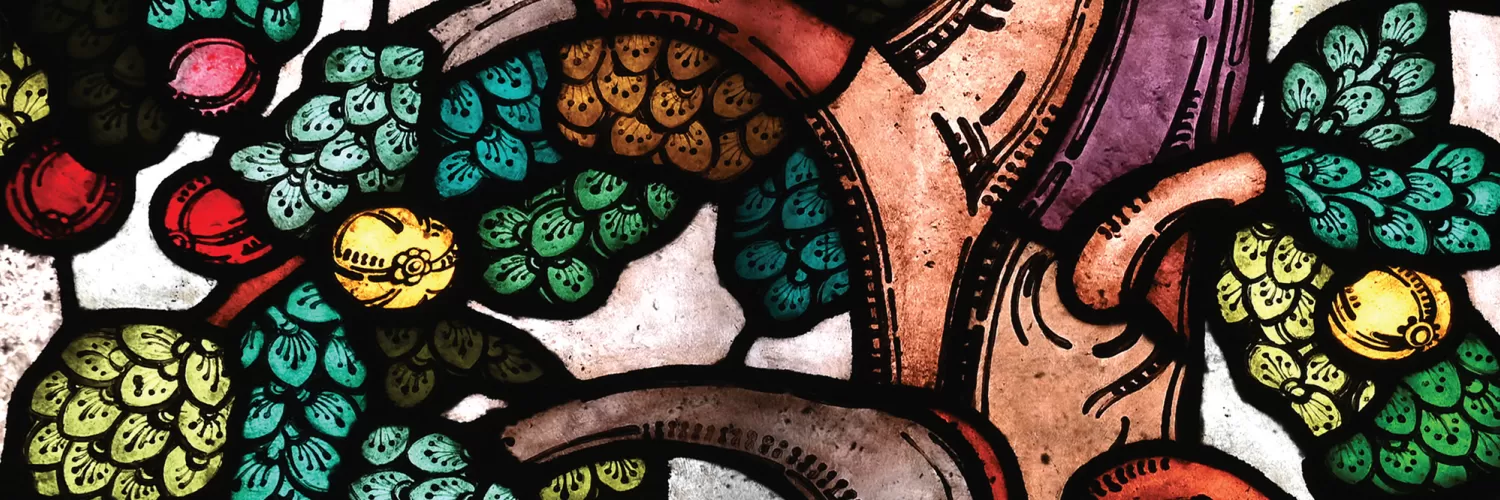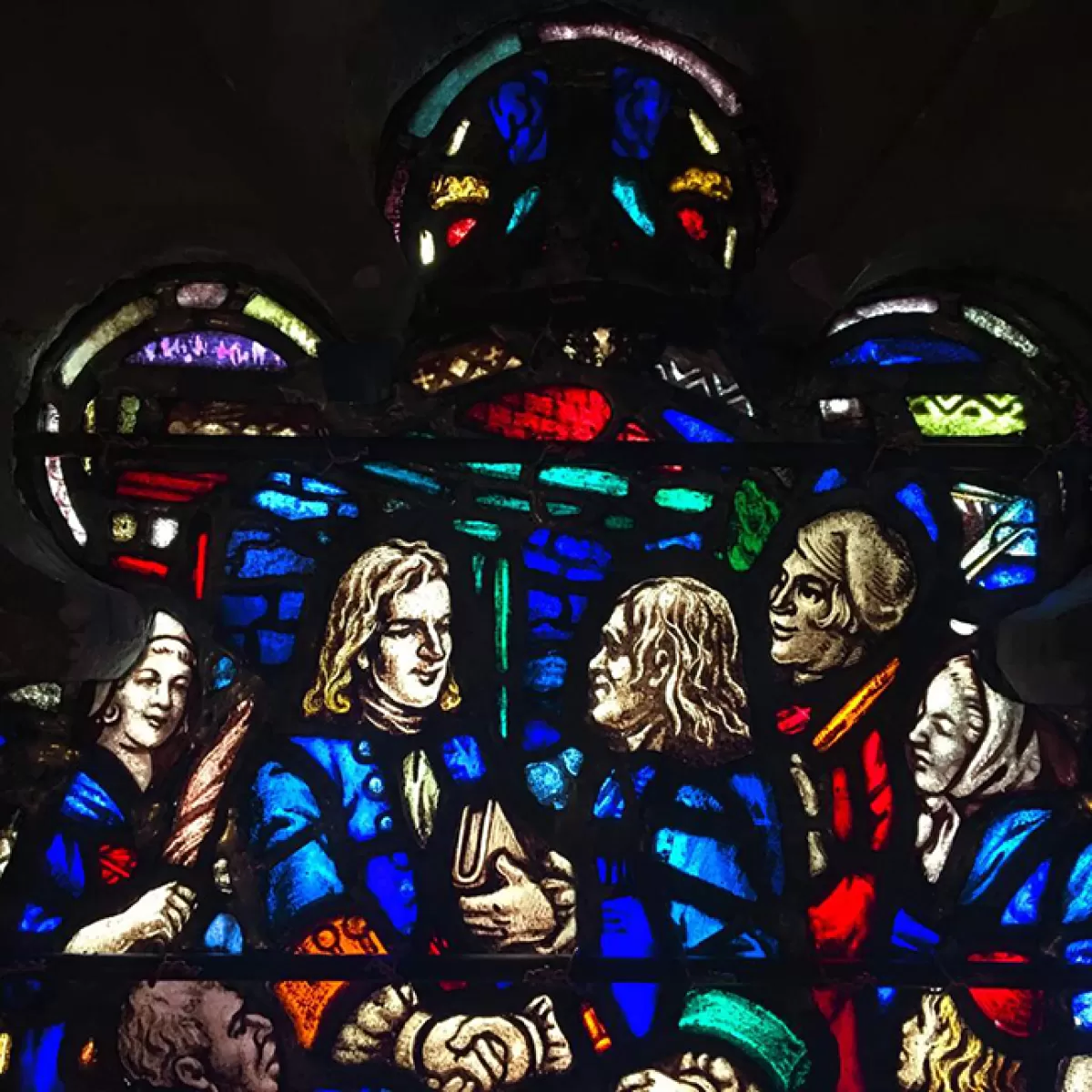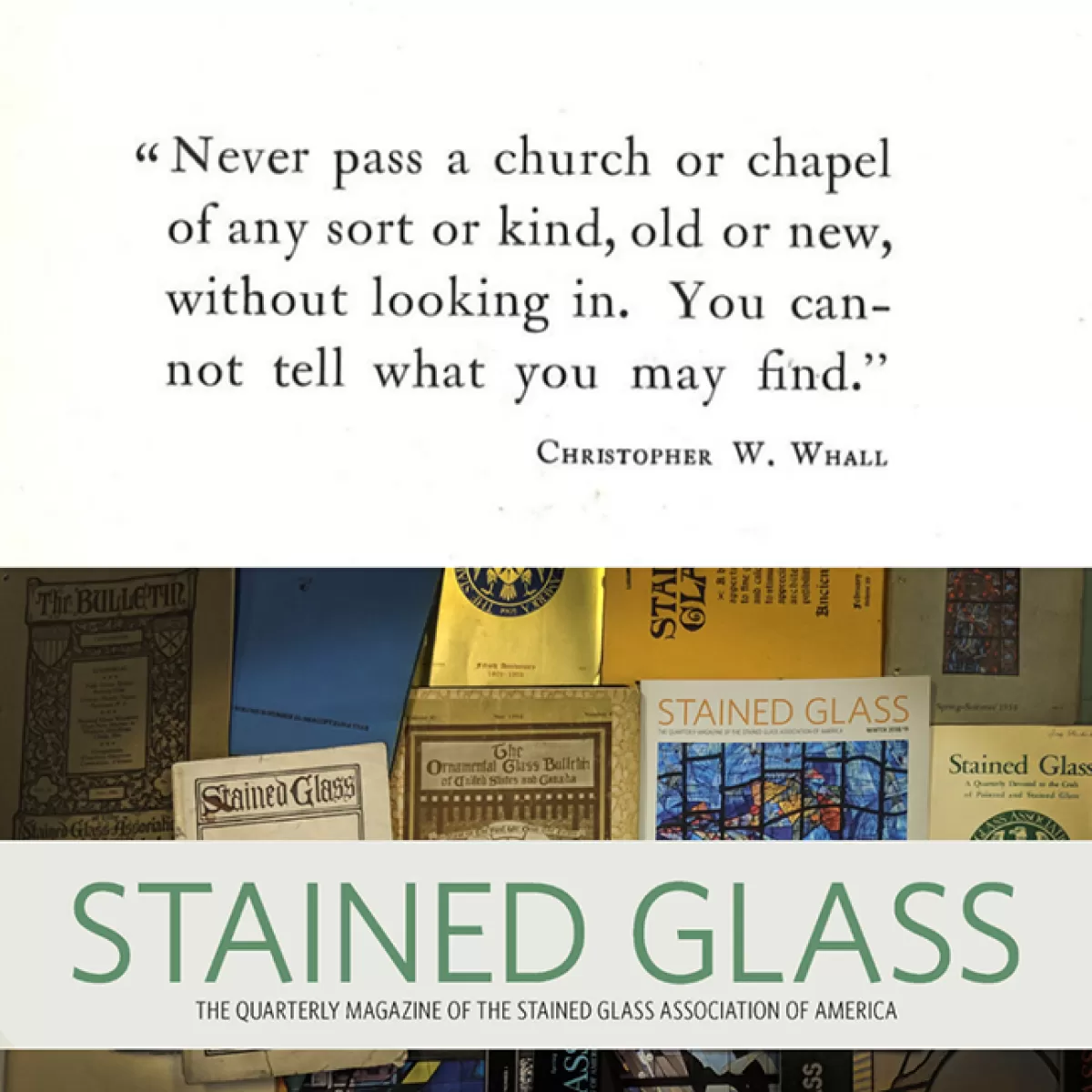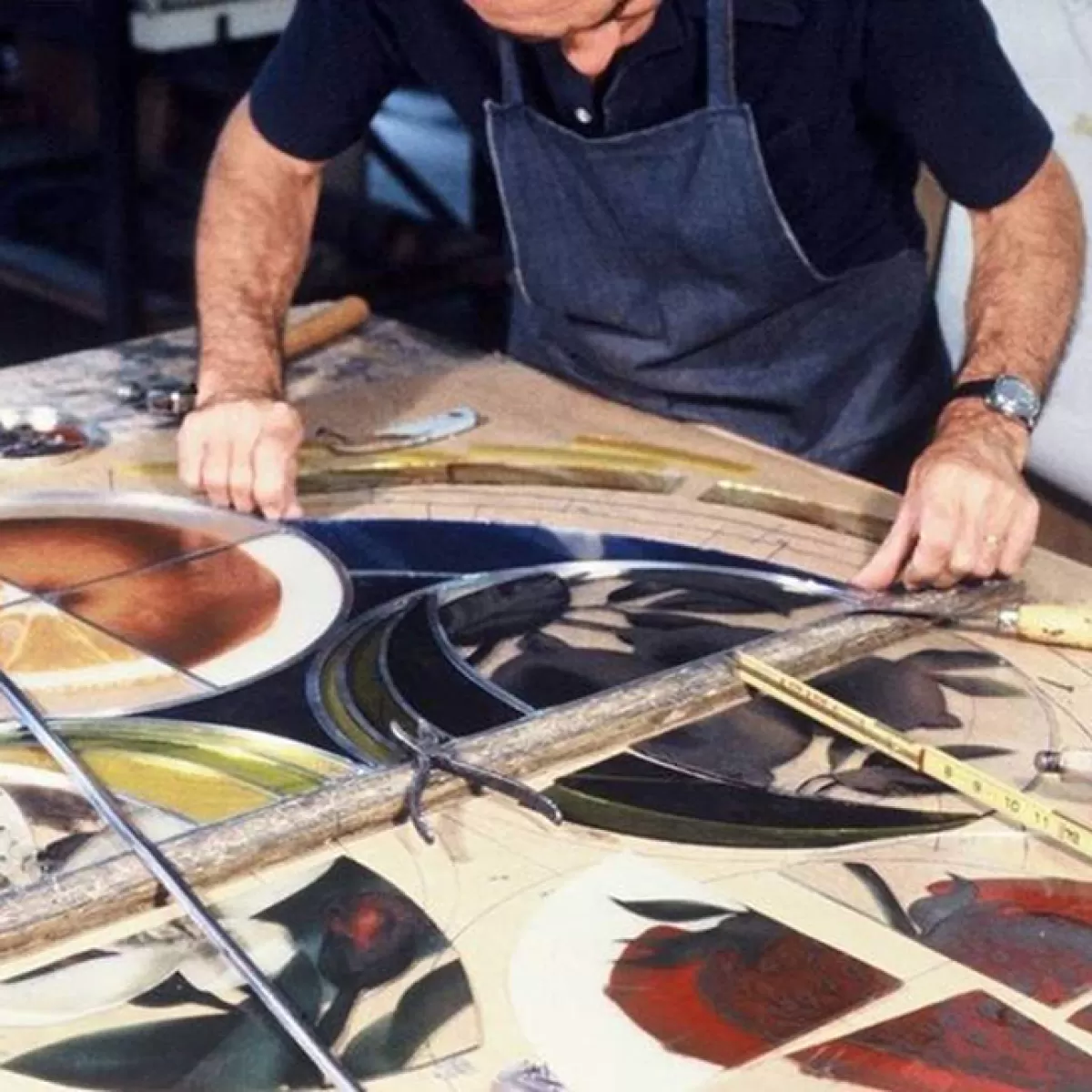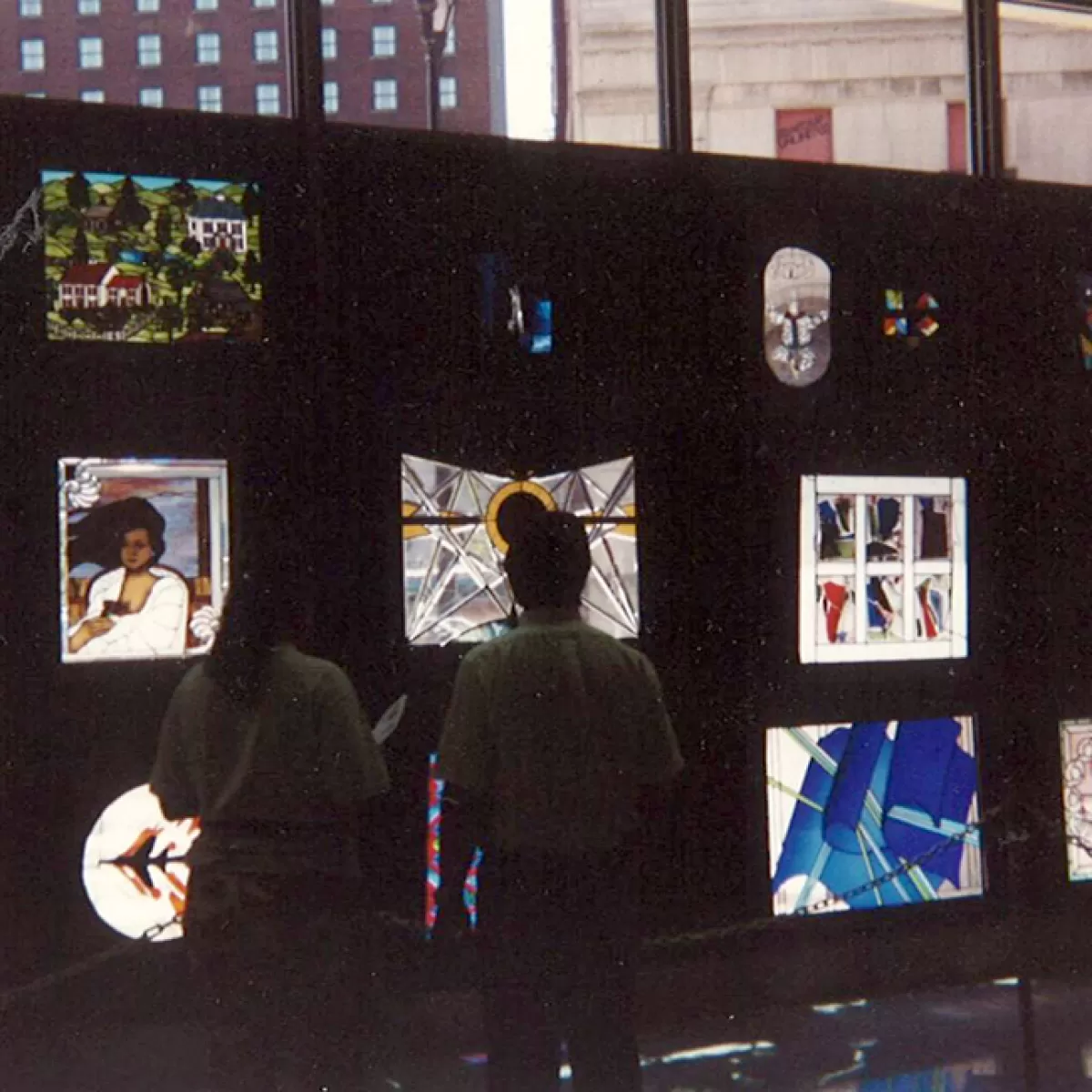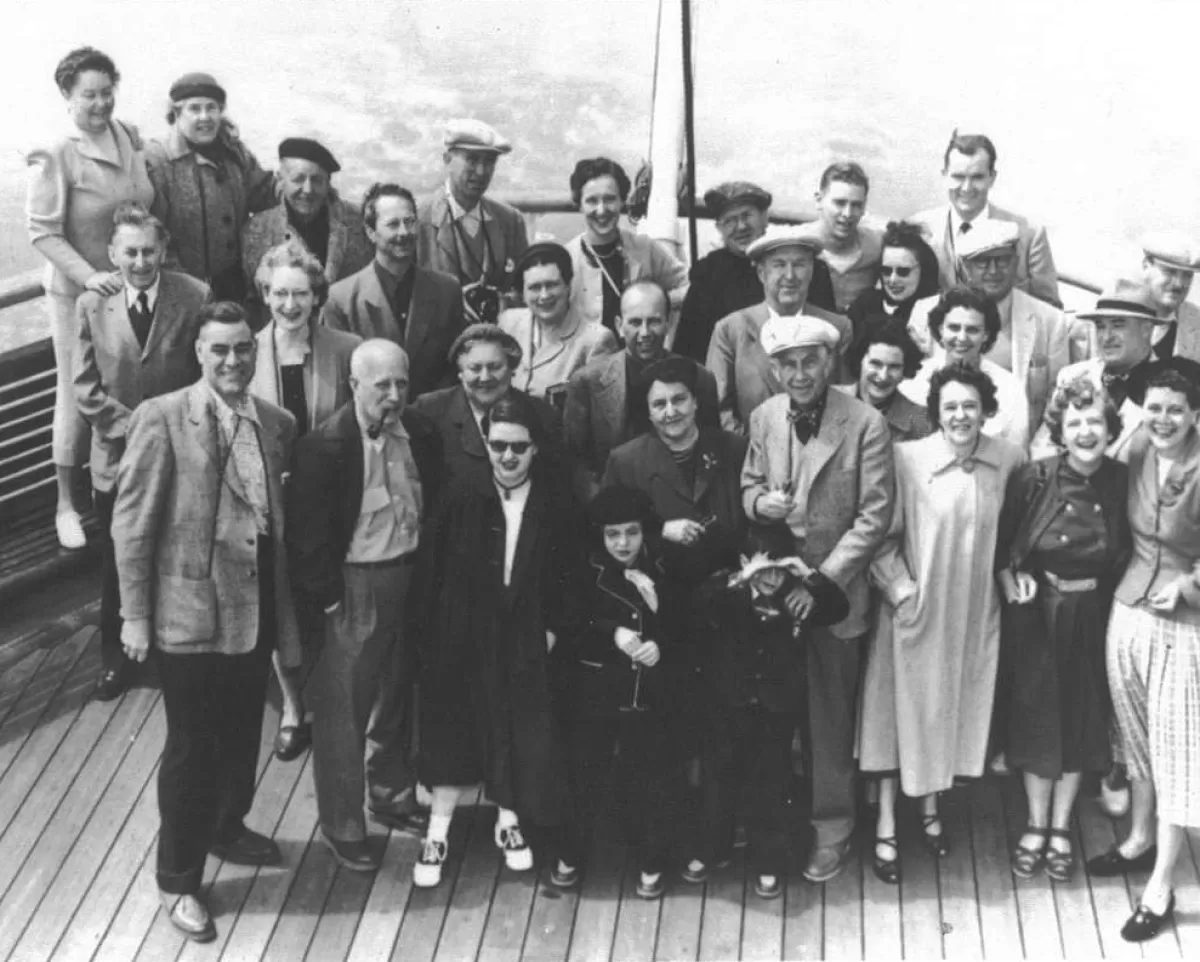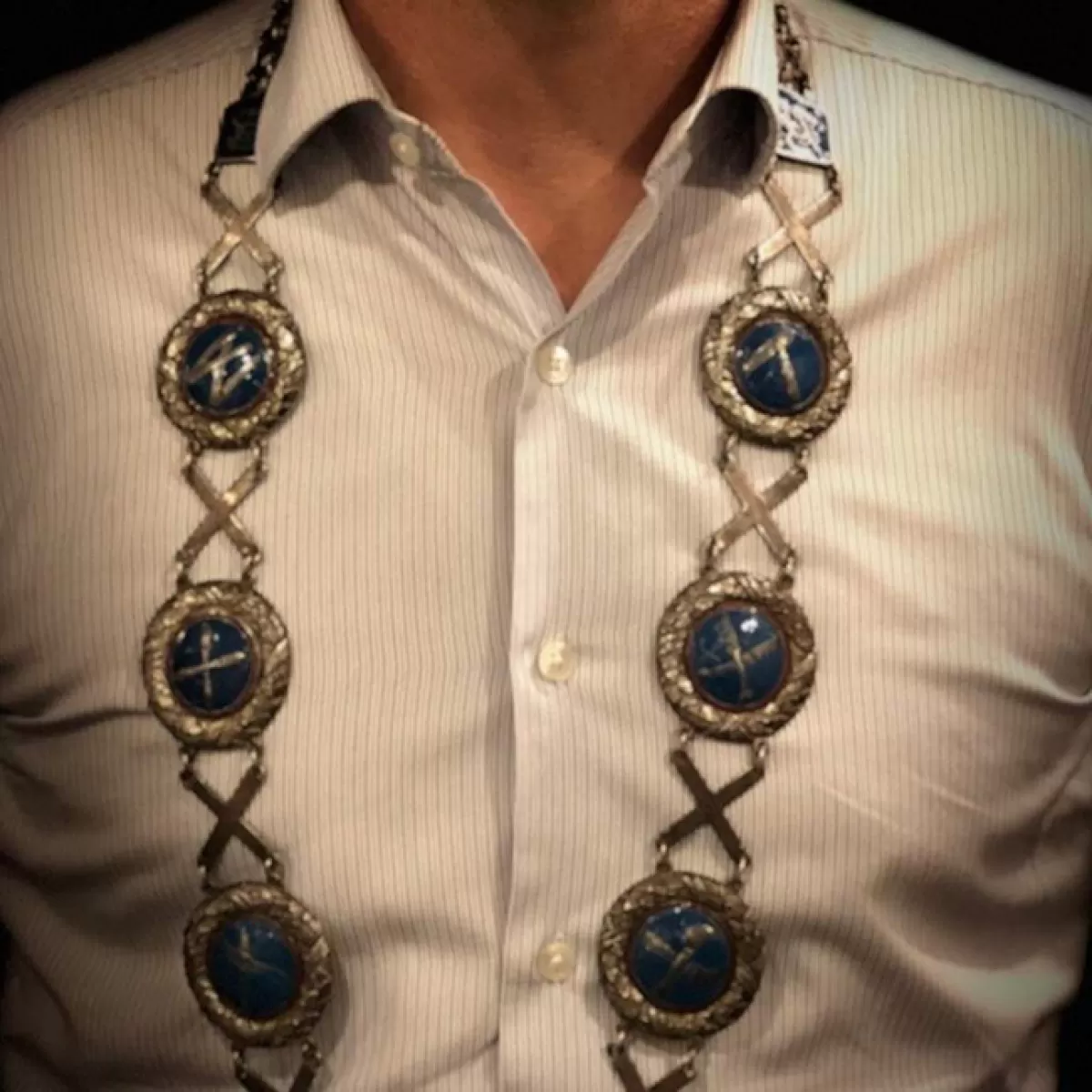SGAA is a 501(c)(6) non-profit corporation acting as a professional trade association. By virtue of this distinction, SGAA is devoted to the improvement of business conditions in the stained glass industry. In 1903, the main reason for the formation of the association formed was to protect the United States' ornamental and stained-glass industry from foreign competition by cheaper European glass imports into the United States. The organization campaigned for decades for high import taxes to be imposed on European glass which was much cheaper than U.S. glass due to the much lower wage costs in Europe, which they described as "unfair competition."
Soon after its founding, it became evident that the members would need some regular means of communication. The Visitor, eventually called Stained Glass, or SGQ for short (Stained Glass Quarterly), was begun in 1906. SGQ has been continuously published through WWI and WWII and countless other national emergencies. It is now one of the oldest continuously published trade journals in the United States and has enjoyed several awards for both its content as well as its graphic design. For over 100 years, our journal has documented the history of architectural glass providing a voice to the stained glass industry, publishing both member and non-member projects of merit. Its archives are treasured by historians and aficionados all over the world for its technical, artistic, educational, and inspirational content. Today it continues to be the industry standard, covering excellence in architectural art glass.
Founding of the Stained Glass Association of America
The National Ornamental Glass Manufacturers Association, now known as the Stained Glass Association of America, was organized in July 1903 at the Southern Hotel in Columbus, Ohio. In this meeting, 26 men represented 45 stained glass firms in person or by proxy.
The major impetus of the meeting was money. The stained glass industry felt that European competition was unfair. In the decade before the formation of the National Ornamental Glass Manufacturer's Association's founding, another group—The United States Glass Workers—petitioned the U.S. Congress to create tariffs to equalize the European glass worker's wage scale with that of America's, a difference of almost three to one. Even more devastating than foreign competition was the domestic competition with debilitating price-cutting being the norm in the difficult depression-like era at the turn of the century.
Otto W. Heinigke wrote in 1923 that the purpose of the Association stated in its constitution is "in all lawful ways to promote the welfare of its members and bettering of trade conditions generally." (Ornamental Glass Bulletin, June, 1923)
John G. Lloyd in Stained Glass in America lists eight points of the early aims of the Association:
- To put an end to cutthroat competition that did nothing more than encourage poor quality and discourage honest craftsmanship
- To educate the public and help churches and architects to have a better understanding of stained glass
- To promote real aesthetic values and standards for the craft
- To combat low quality and low prices of foreign competition
- To promulgate friendship and understanding among the craftsmen themselves
- To counteract the pressure of organized labor that, at the time, caused unsettled conditions in a largely unorganized craft-industry
- To establish economic standards that would end the practice of ridiculously low pricing that came about through ignorance of how to figure a job
- To raise the standards of the craft both artistically and economically
Ludwig Von Gerichten of Columbus, Ohio was undoubtedly the chief catalyst in the founding of the National Ornamental Glass Manufacturers Association. For a number of years he had corresponded with and visited a large number of studios throughout the country so that by the July 1903 meeting, "every member attending the convention was already favorably inclined toward the idea of a national association." (Ludwig Von Gerichten, "The Founding of the Association," Stained Glass Winter 1976, p. 74)
At the first convention, the Constitution and Bylaws were established. Joseph E. Flanagan of Chicago was elected President, George Mueller of Milwaukee, Treasurer, and Mr. Von Gerichten, Secretary.
The Association Magazine
It soon became evident that the members would need some regular means of communication and Ludwig Von Gerichten began a periodical called The Monthly Visitor. Volume 1, #1 was published in 1906. Its columns were open to all the members for expression of their individual views on any subject that could be of interest to the craft. The publication's economic support came from the suppliers of glass, lead, and other materials of the craft, a practice that continues today.
William G. Speier of Philadelphia took over editorship with the third issue of Volume #1 following his election as secretary of the Association at its second meeting in Boston in February, 1907. The official title became The Ornamental Glass Bulletin.
In 1909, Joseph E. Flanagan, a former Association president, was elected secretary. He took over as editor with Volume 3, #2, a job he held until his death July 4, 1928. In July of 1909, the Association changed the publication's name to The Bulletin of the Stained Glass Association of America.
Flanagan became the first editor to introduce articles that touched on stained glass as an art form as well as reporting the numerous business concerns of the trade. A typical early magazine was approximately one-half advertisement and one-half copy. There would often be a picture of a rather mundane window furnished by a member. The magazine would often contain articles about member studios and short pieces about the glass industry. Following an Association meeting, complete minutes down to motion for adjournment were included.
A great deal of column space was devoted to promoting tariffs on low price European imports, but with few results except during World War I, when France and Germany were completely shut off. However, the primary concern was the members who engaged in unreasonable competition. When the economy would tighten, prices would drop and in many cases windows were being made for less than cost. The magazine crusaded against the practice with a monthly litany of what composed overhead and costs that the art-and-craft oriented members never considered. Evidently, all was of little avail as horror stories of improper pricing were often included in the magazine.
The next editor was Sydney L. Brown, 1928–1931. He continued the same format as the previous editor for Volume. 23, #6 to Volume 26, #9. One interesting addition was the serialization of John A. Knowle's book, The History of the York School of Glass Painting. It ran sporadically from 1929 until 1950.
When Brown retired in 1931, the Association tried a bold experiment with the appointment of Howard B. Burton, an architect, as Executive Director and Field Secretary of the Association as well as editor of the magazine, which was renamed Stained Glass. The format changed; the size increased and a notable addition in his first issue was a complete list of the members of SGAA with street addresses. The experiment ended abruptly in September 1931 with Volume. 26, #9. The Association was teetering on the brink of economic oblivion in the midst of the depression.
Association President Charles J. Connick, by far the leading luminary in American stained glass, led the rescue of the magazine. He appointed a team of part time editors, Harry Lorin Binsse, Maurice Lavanoux (secretary of the Liturgical Art Society) and his own chief associate, Orin E. Skinner. Starting with Volume. 26, #10 they carried on the format begun by Mr. Burton until Orin Skinner became sole editor with Volume. 28, #4.
The magazine became a quarterly with the spring issue, 1933 and has remained one until today. Skinner promptly reduced the size to 5 x 8 inches and embellished the neutral gray covers with color plates left over from Connick's great book, Adventures in Light and Color. The Association and the magazine surely would have disappeared during the depression had it not been for Connick and Skinner constantly pumping life into it.
By 1948, the Second World War was over and Stephen Bridges, a fine stained glass artist with a wonderful command of the English language, took over from Volume 43, #3 through Volume 46, #2.
In 1951–1958, the work of editorship shifted to still another quiet unassuming craftsman located in San Francisco. Norbert Graves maintained the general Skinner format with Volume 46, #3 to Volume 53, #3.
A notable change, reminiscent of 1931, was instituted in 1958 when John G. Lloyd was hired as Editor and Executive Secretary of the Association. Although interested in art and photography, he had little knowledge of stained glass. He grew rapidly in the job and in 1963 wrote the fine book Stained Glass in America, the first book to really explore the industry in this country. He changed the format back to a larger size 7 x 10 and gradually began to use color after 1959. He also introduced the use of the SGAA seal on the back of the magazine.
Lloyd's tenure ended in 1970 with Volume. 65, #2 and William S. Clark, who was editor of Your Church Magazine, took over until he died in 1972 and was replaced by former editor Maurice Lavanoux. He published Volume. 67, #4 through Volume 69, #4.
In 1975, the Association hired Dr. Norman Temme, a Lutheran Pastor with wide experience in public relations. His nine-year tenure witnessed some of the most dramatic changes in the publication. Working with Richard Brauer of the Valparaiso University Art Department, he doubled the content size of the magazine and introduced a number of new features, including four-color reproductions, which was made possible by Ken Urschel, General Secretary, who had originally recommended Dr. Temme for the job of editor. The magazine went from being a trade journal to a fine display magazine that was read internationally as the definitive publication about stained glass. Also, the magazine began to be indexed, increasing its use as an archived publication. Dr. Temme's last issue, Volume 79, #2, was actually put together by transitional editor Kenneth vonRoenn, Jr., a talented young glass designer.
Then came a dramatic year under the inspired artistic direction of noted glass painter and author Richard Millard with Volume 79, #3 – Volume 80, #4.
Richard L. Hoover, a former glass craftsmen from Kansas City, replaced Millard in 1986 from Volume 81, #1 to Volume 90, #3. Under Mr. Hoover's direction, Stained Glass as the official magazine of the Association became one of the most important documents of the information about the art and craft of stained glass on a worldwide basis. He enhanced the high artistic standards instituted in the Temme regime and continued in the Millard regime.
Stained Glass School
The SGAA founded a stained glass school in North Adams, Massachusetts in 1977 to serve as the training center for The Stained Glass Association of America. Association members saw a rapidly growing need for development in professional studio methods of stained glass design and assembly.
Approval was given the plan at the SGAA's 1977 Summer Conference in Dallas, and the Executive Committee named H.W. "Bill" Cummings as Institute Director. A nine-member board of directors was appointed by the Stained Glass Association of America to direct the Institute. SGAA treasurer and past president Otto Winterich served as chairman. Richard Millard, Kenneth E. Urschel, Helen Carew Hickman, John Kebrle, Paul Dufour, Albinas Elskus, William Laws and John Nussbaum assisted him.
During its first three years of operation, 400 students attended classes in North Adams. Inflationary increases in travel costs, difficulties in travel and housing accommodations, and inclement winter weather, began to take their toll on enrollment. At the same time, there was a strong appeal to the school to provide classes closer to the homes of potential students.
Members of SGAA's Educational Committee, who served as trustees of the school with then-chairman William Malone, responded to those appeals. Regional classes began in January of 1981. It marked a major shift in emphasis for the school organized in 1977 to serve as the training center for The Stained Glass Association of America.
By establishing a program of courses offered in more than one location, it was hoped that revenue could be raised to help diminish the escalating operating expenses at North Adams. A few such classes had in fact already been tried, successfully, with the energetic cooperation of Elizabeth Perry (WA), Don Sharp (TX), Penny Starr (CA), Rick Hoover (MO), Dennis Harmon (TN), Chetty Mastroianni (TN) and Thurmon Radford (VA).
Financial problems continued to plague the Stained Glass School. During the 1981 SGAA Annual Summer Conference, the Stained Glass School in North Adams was closed by action of the SGAA Board of Directors. Upon the election to the Board of Directors during the 1981 Summer Conference, Elizabeth Perry was appointed, by then-President John Kebrle, to be Chairman of the SGAA Education Committee and concurrently Director of the Stained Glass School.
The regional classes continued under the direction of Perry in 1983 and 1984. During that time, she also initiated "Members Only" workshops at Mackinac Island, MI; Boulder, CO; Dallas, TX; and Minneapolis, MN. Following Elizabeth Perry's direction, Florence Welborn was appointed Chairman of Education and Director of the Stained Glass School at the 1983 Summer Conference in Palo Alto, CA. She brought with her a plan to expand the educational base of the SGAA Stained Glass School's Programs. The plan was threefold:
- To establish the procedures for teacher accreditation by the initiation of criteria and establish standards and testing procedures, in order to assure competent and qualified teaching in the area of stained glass and related subjects
- The re-establishment of a regional training program utilizing participating certified instructors who have qualified through the SGAA Teacher Accreditation Program
- To create a comprehensive, encyclopedic manual on stained glass. The proposed design of the manual would serve as a permanent reference on stained glass for the professional as well as a text for those wishing to teacher the craft.
The second goal was realized by the appointment of Kay Botkin as Regional Craft Training Director in 1985 to launch the program, although this program was later discontinued due to a lack of available accredited teachers. The third goal produced the first edition of the Reference and Technical Manual under the guidance of Florence Welborn and her brother, William Davisson.
From 1989 until her death in 1991, Dorothy Maddy served as Director. During her tenure, the focus was on updating and printing the Second Edition of the SGAA Reference and Technical Manual for stained glass.
Barbara Krueger followed Maddy as the Director of the school. Work was undertaken to broaden educational programs by sponsoring speakers and workshops at the annual SGAA conferences. Krueger finished the work begun by Maddy on the SGAA Reference and Technical Manual, Second Edition.
In 1994, Walter "Spike" Grosvenor became the Director of the Stained Glass School. During his tenure, the SGAA Reference and Technical Manual, Third Edition was begun. This revised and updated edition is also available on CD-ROM. The Stained Glass School also currently sponsors several scholarships, including the Dorothy L. Maddy Memorial Scholarship and the Steven Bridges Memorial Scholarship. These scholarship efforts are supported by a biannual silent auction that takes place during the SGAA Summer Conference.
In 1985, the first Alberto Garcia Award for Excellence in Education was awarded to Dorothy Maddy. The future financial benefits from this donation were then used to assist in the development of the Reference and Technical Manual. With the completion of the second edition, the original award program for teacher excellence was reactivated as a Stained Glass School award. In the summer of 1991, it was awarded to Helene Weis. The Stained Glass School continues to introduce new educational programs to fulfill the needs and requests of the stained glass community.
Exhibits
Next to the magazine, Stained Glass, the most meaningful activity of the Association has centered on exhibitions of stained glass which have, over the years, reached throughout this country, South America and as distant as Poland. Undoubtedly, the most significant was the "New Work in Stained Glass," organized in 1953 as a cooperative effort between the Association and the American Federation of Arts.
Sensing that ecclesiastical stained glass was not news worthy enough for the mass media, an invitation to be juried was extended to all artists in this country, not merely those in the stained glass field. Artists were asked to submit a design for a stained glass panel that would be exhibited first in New York and then circulated around the country by the Federation of Arts.
Eighteen panels were finally made after several hundred entries had been whittled down. The selection included well-known stained glass artists such as Joep Nicholas, William Haley, Robert Harmon, William Schickel, Marcolino Maas, and Francis Deck. It also included nationally recognized painters who had never done stained glass such as, I. Rice Periera, Abraham Rattner, Andre Girard, Peter Ostuni, Max Spivak, Adolph Gottlieb, Hans Muller, Alfonso Ossorio, and Siegfried Reinhardt who provided designs that were fabricated by member studios.
The panels displayed a spectacular variety of modern techniques such as fusing and laminating as well as more conventional leaded and painted stained glass. They were done, for the most part, in ways beyond the imagination of the average studio laboring to please a particular client. The best thing about the show was no one ignored it.
The New York Times, Herald Tribune, and Art Digest all contained extensive reviews and photographs and several of the painters such as Gottlieb and Rattner were later chosen for major stained glass commissions. At the Association Conference in 1954, the panels were displayed at the Cincinnati Art Museum and elicited a broad spectrum of responses from the members. Written comments (anonymous) ranged from "The cases and frames were the best part of the show," to "The best thing the Association ever sponsored."
Another important on-going show was at the National Episcopal Cathedral in Washington, D.C. The exhibit, which is mainly about the techniques of making windows, became part of the Cathedral's permanent exhibit in 1956. It has been viewed by tens of thousand of visitors over the years.
"Stained Glass, USA; New Directions" was another joint effort of SGAA and the American Federation of Art prepared under the sponsorship of the United States Information Agency for Latin America. It was comprised of the 18 panels from the "New Look Show" along with actual panels and sketches provided by a number of Association studios. All the titles were in Spanish and it was exhibited in Mexico City; Guatemala City; Quito, Ecuador; Santiago, Chile; Montevideo, Uruguay; and La Paz, Argentina during 1957 and 1958.
It was the brainchild of Harold Rambusch and Henry Lee Willet, who also organized and produced the "New Work Show." It again received wide spread press coverage with headlines such as "Revival in Glass...Stained Glass has graduated from the Gothic."
One of the Association's most unusual efforts was an exhibit and demonstration workshop at the International Trade Fair in Poznan, Poland in 1958. It was continued in the American Pavilion sponsored by the United States Government. Henry Lee Willet did the demonstrations with the aid of local Polish glass people, and the exhibit consisted of a number of panels donated by Association members including six prizewinners from the 1956 Apprenticeship competition. A large 35 foot high window, which was part of the display and made of glass donated by the Blenko Glass Company, was given to the Archbishop of Poznan as a parting gift. During the six weeks of the fair, well over 100,000 people had the opportunity to learn that the United States is not all automobiles and fancy appliances, but that handcrafts are still a part of the fabric of our country.
Biennial apprenticeship competitions began in 1948 as a survey to see how well the apprentice programs begun in 1945 were doing. Forty applications were received and 25 panels were actually displayed at the annual Association conference.
The apprentices were usually given criteria for design, size, and frames. Prizes were offered for first and second, a number of honorable mentions divided into glazier and artist categories were awarded. Both a jury and popular vote judged them. The show was held at the annual conference every other year to coincide with the Presidential election, so that through the 50s and 60s the maximum number of people would be able to see it. The exhibition, of what were often some outstanding and innovative panels, became one of the most popular parts of the meetings.
After 1978, apprentices were so diminished in numbers there were not enough entries to have a representative show. The Associates, a strong and dynamic group in SGAA that emerged in the 70s, took over and arranged their first show in 1979. The Associates show grew under the direction of Helen K. Olson, and in 1985, was the highlight of the annual conference with an outstanding exhibit at the Royal Ontario Museum, Toronto, Canada. Other fine Associate shows took place in Chartres, France (also in 1985), St. Louis in 1986, and Corning, New York in 1987.
Today, the Associates show has evolved into the biannual All-Member Show, which is open to all members and affiliates of SGAA.
Another notable exhibit was an outstanding show of artist-designer members' work at the 1980 Kansas City Conference where Rick Hoover arranged to have the panels displayed in the window wall of the Crown Center. The artist-designers also organized a wonderful photographic and design show at the 1987 Corning Conference.
An outstanding event at the 1987 conference was the International Competition and Exhibition with a display of 43 panels from Canada, Japan, Australia, Belgium, England, Italy, Israel, Ireland, Switzerland and 14 states in the U.S.A. The panels were displayed in the lobby of the finest glass museum in this country, the Corning Museum of Glass.
Exhibitions have been the lifeblood of the Association's work because seeing actual pieces is important to understanding stained glass in all of its nuances.
Conferences & Tours
The highlight of each year is the Annual Convention. Business is discussed, motions made and voted on, officers and executive committee members elected, reports read and exhibitions displayed. But the key reason for coming back year after year is the magic of the unplanned intermingling of artist, craftsmen, business people and suppliers. They exchange ideas, have seminars and socialize, but it is the chemistry generated by these diverse people that make the Association unique and the focal point of the stained glass craft.
Several times in its history, SGAA sponsored post-conference tours. In June of 1926, Editor J. E. Flanagan led a party of 16, including Association President Henry Hunt, on a post conference tour of England and France. They visited all the high points of medieval and renaissance architecture including Canterbury, York, Wells, and Oxford. The group was lead by a British guide following an itinerary planned by the British Society of Master Glass Painters. The trip wound up in France with visits to Amiens, Tours, Angiers, Chartres and Paris.
1953 marked the 50th anniversary of the Association and after a brief business session in New York City, 32 persons left Hoboken the evening of April 26 on the Holland-American liner Ryndam bound for an unforgettable six week tour of France, Switzerland, Belgium, and Holland. A few of the trip highlights included a party given by the Saint-Gobain Glass Company of France with noted stained glass artists Paul Bony, Jean Barillet, and Raphael Lardeur in attendance. Three glorious days at Chartres featured a roof top tour of the famous Cathedral led by its architect, Jean Maunoury and day long studies of the stained glass in all types of light conditions. There were also brief visits to the Cathedrals of Bourges, Poitiers, Amiens, LeMans, Reims and many others. The group was able to visit the church of Notre Dame de Tout Grace in Assy where the most famous artists in the world including Matisse, Rouault, and Chagall had been responsible for the glass and other decorative features.
President's Badge of Office
The President's Badge of Office is a "collar" somewhat similar to a wine steward's neck chain. It was designed in 1928 by Henry Hunt, Otto Heinigke, and Sydney Brown, and has a large replica of the Association seal at its base made in silver and enameled in red and blue. The enamels were fired in the kilns at the Rambusch Studio. Smaller medallions with glass worker's tools embellish the chain that hangs around the President's neck. The "collar" is worn by the President at all official functions including meetings and annual reports.
